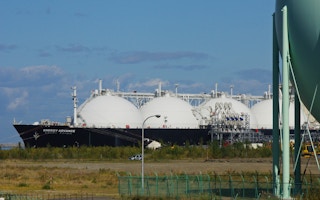While Japan’s domestic demand for liquefied natural gas (LNG) is projected to drop one third by 2030, Japan will remain the biggest gas proponent in Asia – investing heavily in the midstream and downstream gas sector despite climate, regulatory, and financial concerns.
As the world’s second-largest importer of LNG in 2023, Japan has leveraged its market position to secure long-term contracts and manage steady supply of this energy source. Japan’s influence on the Asian LNG market also stems from its significant role as a major hub, re-exporter, and investor in LNG infrastructure across the region.
Asian governments are welcoming this development under the banner of “transitional fuel” and “energy security,” but practical concerns are arising in how the bullish gas plans ignore the financial challenges of infrastructure development, renewable energy (RE) potential in the region, and climate policy restrictions. Moreover, the impacts on electricity costs of Japan’s rapidly expanding regional gas portfolio should not be overlooked.
Japanese utility companies, including JERA, Tokyo Gas, Osaka Gas, and Kansai Electric, are now looking for markets to sell their excess supplies amid the decline in local demand.
JERA, which recently unveiled its $32-billion LNG-focused Growth Strategy 2035, is actively expanding in Asia – with investments in regasification terminals, LNG-fired power plants and gas distribution infrastructure in countries such as Bangladesh, Indonesia, the Philippines, Thailand, and Vietnam. The TEPCO-Chubu subsidiary is also engaged in negotiating new LNG purchase contracts – indicating intention to drive demand in Asia.
JERA may face challenges ranging from potentially seeing a drop in sales margin and being put in direct competition with suppliers. But for host developing countries, opting for gas both in the transition phase and as a long-term energy source poses considerable risks. Gas is inherently volatile and its supply chain is fraught with uncertainty that could result in skyrocketing electricity costs, burdening consumers and businesses, and hampering economic growth.
In Southeast Asia, massive gas plans risk locking in expensive sources of energy for decades, potentially crowding out investment in abundant and more affordable RE.
Electricity affordability issues leave room for doubt when pushing such an ambitious and long-term project.
Lessons can be learned from established markets like Bangladesh with gas as its main energy source, producing around half of its electricity. The Russia-Ukraine conflict has caused a drastic increase in the price of LNG in Asia, and European nations to stockpile their supplies. This leaves little supply for developing countries such as Bangladesh, which has stopped buying spot LNG, or those delivered within two years of purchase, due to high prices. As a result, it faces up to three years of rolling blackouts, forcing cities to cut their electricity supplies.
Emerging gas markets like the Philippines are likely to see this unfold. JERA acquired a 27 per cent stake in Aboitiz Power Corporation, one of the biggest advocates for gas in the Philippines. This is on top of supporting the full-scale adoption of LNG in the Philippines. Experts say, however, that LNG developments will expose Filipino end-users to higher electricity prices.
Given the obvious impact of gas price volatility, mature gas market countries in the region such as Pakistan, Bangladesh, Thailand and emerging gas markets such as the Philippines and Vietnam should consider focusing on renewables.
Renewables not only provide energy sovereignty but also offer a lower cost of energy. For example, the levelised cost of solar power is expected to fall by 64 per cent between 2023 and 2050, compared with just a 5 per cent drop for combined cycle gas turbines. This means that the expansion of gas over renewables in a country’s energy mix is likely to drive more expensive electricity prices and risk unnecessary massive subsidies to make it affordable, while the introduction of more solar power is likely to reduce electricity prices significantly. This has been echoed in industry reports as the International Energy Agency said clean energy technologies are “more cost competitive over their lifespans than those reliant on conventional fuels like coal, natural gas and oil”.
Japanese firms like JERA should reorient their expansion portfolios toward renewable energy to seize opportunities presented by the pace of energy transition. This will not be possible with gas as the primary driver of its development and green growth strategy. By aligning with the global shift towards renewables and fully phasing out their fossil fuel investments, Japanese entities can also drive regional clean energy transitions without exposing countries to unfavourable electricity costs.
Ultimately, breaking away from gas and other fossil fuels will benefit not only the impact of returns to shareholders in the companies but also developing countries and their climate targets. In the face of the escalating climate crisis, it is urgent to pursue a rapid, equitable transition towards establishing 100 per cent renewable energy systems.
Ayumi Fukakusa is deputy executive director of Friends of the Earth Japan. Lidy Nacpil leads the Asian Peoples’ Movement on Debt and Development (APMDD), a regional alliance for people-centered development and economic and climate justice.








